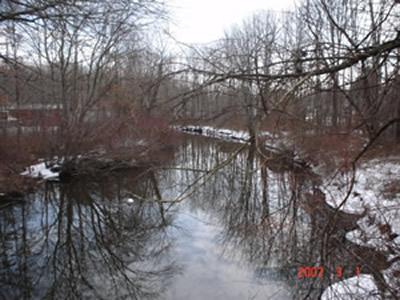Projects & Programs - Watershed Planning & Implementation
Musquapsink Brook Watershed Restoration & Protection Plan, Bergen County, NJ

Based upon the New Jersey Department of Environmental Protection (NJDEP) Ambient Biomonitoring Network (AMNET) data and data collected by the NJDEP/United States Geological Survey (USGS), the Musquapsink Brook is impaired for phosphorus and aquatic life and listed on Sublist 5 of the New Jersey 2004 Integrated Water Quality Monitoring and Assessment Report. Additionally, a Total Maximum Daily Load (TMDL) for fecal coliform has been proposed for 6.6 miles of stream. This TMDL requires a 96% reduction in nonpoint source (NPS) bacteria loads from this residential watershed. The goal of this project is to improve the water quality of the Musquapsink Brook by developing a Watershed Restoration Plan that achieves the required TMDL reductions and reduces the NPS pollutant loading that is contributing to the aquatic life and phosphorus surface water quality impairments so that water quality standards may be met.
This watershed-based plan will:
-
identify the causes and sources that will need to be controlled to achieve the load reductions that are estimated as part of this watershed-based plan;
-
estimate the load reductions expected for the management measures that are identified as part of this watershed-based plan;
-
identify NPS management measures that will need to be implemented to achieve the load reductions estimated as part of this watershed-based plan;
-
identify critical areas for the implementation of these NPS management measures;
-
estimate the amounts of technical and financial assistance needed to implement the plan;
-
identify potential sources of funding to implement each management measure that is identified in the plan;
-
outline an informational/educational plan to enhance public understanding of the project and encourage early and continued participation in implementing the plan;
-
develop a ranking system to identify where resources should be targeted;
-
provide a schedule for implementing the NPS management measures that are identified in the plan;
-
outline a set of criteria that can be used to determine whether load reductions are being achieved over time and if substantial progress is being made toward attaining water quality standards, and
- detail a monitoring component to evaluate the effectiveness of the implementation efforts over time.
Deliverables:
Musquapsink Brook Watershed Restoration and Protection Plan: Data Report, August 2011
- Data Report - Appendix A - Musquapsink Brook Benthic Data Report &Species List, Marion McClary, Jr., Ph.D., Fairleigh
Dickinson University- Data Report - Appendix B - Tabulated Stream Visual Assessment
Protocol (SVAP) Data- Data Report - Appendix C - Quality Assurance Project Plan, RP 07-002 Musquapsink Brook Watershed Restoration Plan, Rutgers Cooperative Extension Water Resources Program
- Data Report - Appendix D - Tabulated Water Quality Monitoring Data
- Data Report - Appendix E - Presentation of Graphed Instream Water
Quality DataMusquapsink Brook Watershed Restoration and Protection Plan, June 2012
- Restoration Plan - Appendix A - Musquapsink Brook Watershed Restoration and Protection Plan Data Report
- Restoration Plan - Appendix B - Optical Brightener Sampling Report
- Restoration Plan - Appendix C - Site Specific Restoration Projects
- Restoration Plan - Appendix D - Select Best Management Practice Concept Designs
Project Funding Source: NJDEP 319(h)
Contacts:
Christopher C. Obropta, Ph.D., P.E., Associate Extension Specialist
Rutgers Cooperative Extension Water Resources Program
14 College Farm Road, New Brunswick, NJ 08901
obropta@envsci.rutgers.edu
848-932-5711
Project Partners:
• Bergen County Department of Health Services
• Fairleigh Dickinson University
• United Water New Jersey
• Woodcliff Lake Borough
• Saddle River Borough
• Hillsdale Borough
• Washington Township
• Westwood Borough
• Emerson Borough
• Paramus Borough
• Oradell Borough
